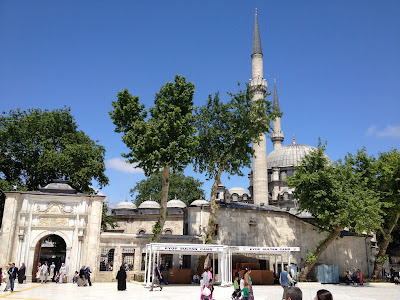Documentary of Sultan Abdul Hamid II
The documentary on Sultan Abdul Hamid II, often referred to as "Abdul Hamid Sani," typically covers this Ottoman sultan's life, reign, and historical impact. Abdul Hamid II was the 34th Sultan of the Ottoman Empire, reigning from 1876 to 1909. His era is one of the most significant in the late Ottoman period, marked by attempts at modernization, intense political struggles, and the empire's gradual decline.
Key Themes in the Documentary:
1. Early Life and Ascension to the Throne:
The documentary would likely start with his early life, education, and the political environment in which he was born. His rise to power is usually contextualized within the internal and external challenges facing the Ottoman Empire at the time.
2. Constitutional Era and Autocratic Rule:
One of Abdul Hamid II's notable acts early in his reign was promulgating the Ottoman Constitution of 1876, which marked the beginning of the First Constitutional Era. However, he suspended the constitution and dissolved the parliament in 1878, leading to a period of autocratic rule.
3. Efforts at Modernization:
The documentary might highlight his efforts to modernize the empire, including administrative reforms, infrastructure development (like the Hejaz Railway), and attempts to centralize power.
4. Pan-Islamism and Foreign Policy:
Abdul Hamid II is known for his policy of Pan-Islamism, aimed at strengthening the bond among Muslims under the caliphate to counteract Western influence and colonialism. His foreign policy and diplomatic maneuvers, particularly his complex relations with European powers, are crucial aspects.
5. Opposition and Reforms:
The documentary would cover the internal opposition he faced, including the rise of the Young Turks movement, which sought to restore the constitution and implement further reforms.
6. The 1908 Revolution and Deposition:
A significant part of the documentary will focus on the 1908 Young Turk Revolution, which forced Abdul Hamid to reinstate the constitution and the parliament, leading to the Second Constitutional Era. His eventual deposition in 1909 and the transition of power would be detailed.
7. Legacy and Impact:
Finally, the documentary would explore his legacy, both positive and negative, and his impact on the subsequent history of the Ottoman Empire and the broader Middle Eastern region.
Historical and Cultural Context:
Visual and Archival Footage:
The documentary would likely use a mix of archival footage, photographs, and dramatizations to illustrate key events and daily life during Abdul Hamid's reign.
Expert Interviews:
Historians and experts on Ottoman history would provide insights and analysis, helping to contextualize his policies and their effects on the empire.
Critical Perspectives:
The documentary might also delve into different historical interpretations and debates surrounding his rule, including his controversial measures and the criticisms leveled against his administration.
Overall, a documentary on Sultan Abdul Hamid II aims to provide a comprehensive overview of his complex and often contentious reign, shedding light on a critical period in Ottoman and world history.
Tomb History:
Sultan Abdul Hamid II's tomb is located in Istanbul, Turkey. The history of his final resting place is intertwined with the complex legacy of his reign and the political changes that followed his deposition.
Background on Abdul Hamid II
Abdul Hamid II ruled the Ottoman Empire from 1876 to 1909. His reign saw significant attempts at modernization and centralization, but also a retreat into autocracy after initially supporting a constitution. He was eventually deposed by the Young Turks in 1909 and spent the remaining years of his life under house arrest in Istanbul until he died in 1918.
The Tomb's History1. Death and Initial Burial (1918):
Sultan Abdul Hamid II died on February 10, 1918, in Istanbul, which was still under Ottoman control during World War I. He was initially buried in the mausoleum of his grandfather, Sultan Mahmud II, located in Divanyolu, a major thoroughfare in Istanbul’s Fatih district.
2. The Tomb of Sultan Mahmud II:
This mausoleum, where Abdul Hamid II was interred, is a historically significant site. Built-in 1840 by Sultan Abdulmecid I, it is an ornate structure that houses the graves of several Ottoman sultans and other royal family members. The tomb reflects the classical Ottoman architectural style with Baroque influences, featuring intricate decorations and a serene interior.
3. Posthumous Considerations:
Abdul Hamid II’s burial in this prestigious mausoleum indicates the complex legacy he left behind. Despite being deposed and living the last years of his life in relative obscurity, he was given a burial place befitting an Ottoman sultan.
4. Cultural and Historical Significance:
The tomb of Sultan Mahmud II, where Abdul Hamid II rests, remains an important historical site. It attracts visitors and historians interested in the late Ottoman period and the dramatic changes that took place during and after Abdul Hamid II's reign.
5. Preservation and Public Access:
Over the years, the tomb has been preserved and maintained by Turkish authorities. It serves not only as a burial site but also as a cultural heritage site, offering insights into Ottoman history and architecture.
Legacy
Sultan Abdul Hamid II's tomb, located in the mausoleum of Sultan Mahmud II, is a testament to his complex legacy. His burial in a prominent and historically significant mausoleum reflects his status as a notable figure in Ottoman history, despite the controversies and challenges that marked his reign. Visitors to the tomb can reflect on the turbulent era of his rule and the lasting impact he had on the Ottoman Empire and its eventual transition into the modern Republic of Turkey.
.jpg)
.jpg)
.jpeg)
.jpeg)

Comments
Post a Comment